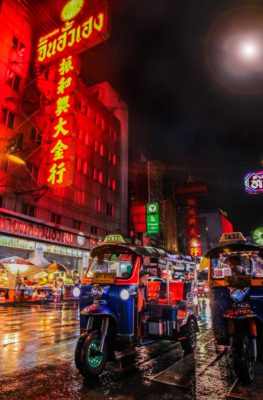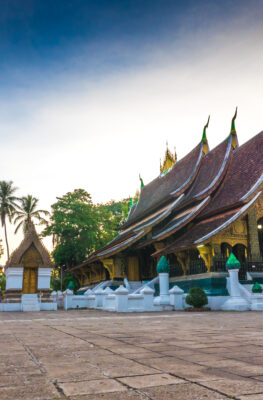Published on April 3, 2018
Cooking class in Kuala Lumpur, Malaysia. Image courtesy of Soraya Nicholls.
You didn’t travel all the way to Southeast Asia to just watch the sights go by from behind your bus window. No – you came here to get your hands dirty, to sink fingers knuckle-deep in the local culture, whether it’s the food or the handicrafts or a popular trade.
Listen to these travelers explain what hands-on experiences taught them about their Southeast Asia destination, and what they learned afterward.
“Kampung” Cooking in Malaysia
The multiple cultures of Malaysia make up a large part of its magic – and exploring the cultural fabric with a cooking class is “the best way to learn about the history and culture of this wonderful country,” explains Hello Raya‘s Soraya Nicholls (Instagram|Facebook|Pinterest). “Through learning how to cook this delicious cuisine, you build an appreciation for the diverse history of this country.”
The three main cultural communities that constitute Malaysia – the Malays, Chinese and Indians – make their presence and interactions felt through the local food. Soraya found this in a cooking class in Kuala Lumpur, of which there are plenty to choose from.
“My pick of the bunch is the LaZat Cooking Class, which is run from a traditional Malay ‘Kampung” style house in Kuala Lumpur,” Soraya says. “They have been running now for over 10 years and are the best at teaching students the art of Malaysian cuisine.
“The classes are all hands on, which means you do all the cooking, which is truly the best way to learn. The class even includes a market tour so you can learn about all the unique ingredients that exist in the Malaysian cuisine,” Soraya explains.
Batik making class in Yogyakarta, Indonesia. Image courtesy of Mike Aquino
Batik making in Yogyakarta, Indonesia
“Why shop for a batik if you can create your own?” asks Claudia Tavani of My Adventures Across The World (Facebook|Instagram|Twitter). “One of the best ways to learn a bit more about the culture and the people of Indonesia is participating in a batik making workshop – under strict supervision of some very patient teachers, it is possible to create one’s own design.”
In Yogyakarta’s famous batik quarter, tourists are offered the chance to make the famous Indonesian fabric patterns by themselves. “Participants are typically provided with the white cloth, on which they can draw their favorite design – using their own creativity, or copying from an already existing one,” Claudia says. “Next, they will be given what look like pens that have a hot wax tank, and with which they have to draw on top of the pencil design.”
Batik is a wax-resist process: the wax lines drawn by batik makers prevent the dye from penetrating the cloth. After the wax has cooled down, the cloth is placed in dye for a few hours to soak in the color. Washing the cloth in warm water removes the wax, and brings out the design. “The process can be repeated multiple times to create intricate designs,” Claudia says.
She and her fellow travelers found that batik pattern creation is easier said than done – “making a batik is actually quite difficult; but participating in a workshop allows tourists to appreciate this craft and understand the patience behind it,” Claudia says.
Thai cooking class. Image courtesy of the Tourism Authority of Thailand.
Thai cooking basics in Koh Lanta, Thailand
“Learning to cook can be a gift in many ways,” explains Family With Latitude‘s Nicole DeBickes (Twitter|Facebook|Instagram). “But learning to cook while outside enjoying the breeze, having a cocktail, and overlooking the beach in Koh Lanta, Thailand is the best reward.”
On her last visit to this Thai beach paradise, Nicole headed to a local kitchen instead to learn how to prepare Thai food, the way locals have done so for millennia. “First you try all the raw ingredients like fish sauce, soy sauce, palm sugar, and more,” she explains. “Then you get to make your own curry paste with a mortal and pestle. This step takes a while, but it is fun to pound away.
“Next you prep all your ingredients for your big moment of where you get in front of the wok. Then you go to work and cook your heart out – cooking over the wok happens really fast and is the shortest part.”
The best part, Nicole says, “is getting to eat the results of your labors.” If you want to do what Nicole did, where she did it, she explains that “there are several excellent places in Koh Lanta where you can take these cooking classes,” she tells us. “Don’t worry if you aren’t a chef – they show you what to do and how to do it at every step. Even my cooking illiterate family was able to do everything.”
Showing off broom-making materials in Cambodia. Image courtesy of Jolene and Andrzej Ejmont.
Broom Making in Siem Reap, Cambodia
“On our recent trip to the Kingdom of Wonder – Cambodia, we had an amazing day in one of the villages next to Siem Reap – we learned how to make traditional Khmer straw brooms,” Jolene and Andrzej Ejmont from Wanderlust Storytellers (Facebook|Instagram|Twitter) tell us. “Although it may sound to some like a not very fun experience, believe me, it was rather eye-opening.”
Most straw brooms are made by professionals – “in Cambodia, locals don’t make brooms just for fun or to keep traditions alive – those brooms are created to sell them at the markets and to support the whole family,” Jolene and Andrzej tell us. “It is a family business and the women are trained in the craft since very young age.”
The Wandering Storytellers – Jolene, Andrzej and their daughters – spent a few hours trying the craft for themselves – and found “the experience of creating something out of straw was an extraordinary lesson to how much easier our lives in Australia really are.”
More than just introducing them to an unfamiliar skill, that afternoon taught them “about the value of small things – I will never look at my broom the same way again.”
Plowing a rice field with a water buffalo. Image courtesy of Heather Cole.
Working like a rice farmer in Luang Prabang, Laos
Conversant Traveller‘s Heather Cole (Facebook|Twitter|Instagram) put herself in a rice farmer’s flip-flops in Laos, and loved it. “Becoming rice farmers for the day is certainly one of the more unusual activities we’ve tried on our travels,” she says, “but definitely one of the most fun!”
Heather visited the Living Land Rice Farm, an organic farm run by the local community just outside Luang Prabang in rural northern Laos. “Visitors are welcome to come and experience the life of a rice farmer, learning and taking part in all stages of rice production,” Heather tells us.
The experience was eye-opening: “From planting and threshing to grinding and even having a go a ploughing the paddy fields with a water buffalo (harder than it looks!), it’s a great way to get to know more about Lao culture and meet the farm workers on their own turf,” Heather explains. “We also got to try a spot of bamboo weaving, making tools with the blacksmiths, and even
crushing sugar cane so we could taste the sweet refreshing juice.”
To unwind after a hard day’s work, “it was time to tuck into some tasty treats, all made from rice of course, including some rather potent rice wine,” Heather says. “Delicious!”
Jamu from Indonesia. Image courtesy of Amelie Gagne.
Taking a Jamu-making class in Bali, Indonesia
For Indonesians, the herbal medicine known as jamu is a way of life. “‘Jamu’ means medicine, but it is also a drink you can find at many health food shop and restaurants, especially around Ubud,” explains Mostly Amelie‘s Amelie Gagne (Facebook|Twitter|Instagram). “More traditionally, you can see women carrying basket on their heads with little bottles of jamu for sale.”
Jamu is actually a million-dollar industry in Indonesia (“There’s apparently a jamu for any ailment,” Amelie tells us) – but its ingredients are simple to source and mix together. “It’s generally made mainly of turmeric (giving it its bright orange color) as well as other plants, ginger, galangal, herbs, palm sugar, and nuts,” Amelie says.
“It can be quite strong tasting and not for everyone’s palate, but it’s definitely worth a try if you visit Indonesia, plus it’s really good for you!”
Making jamu is an experience many visitors to Ubud try for themselves, as Amelie did on her last trip there. “I learned how to make not only jamu, but also other traditional Balinese beauty and health products such as boreh (a spicy body scrub), a fresh facial, body masks and a hair tonic oil – all with plants,” Amelie says. “I was also given the full recipe which you can read on my blog.
“Overall it was a fantastic hands on experience for those of you who like healthy eating in different cultures!”
Cat Ba fisherman’s boat. Image courtesy of Mike Still.
Fishing at Cat Ba, Vietnam
Not all tourists can get the kind of access that Live Travel Teach‘s Mike Still (Facebook|Twitter|Instagram) got for his hands-on experience in Vietnam; his story is worth telling, nonetheless.
“I managed to get connected with a Vietnamese Television show who took me to a floating fishing village at Cat Ba Island,” Mike recalls. “We spent two nights at a resort nearby, and visited the village to learn how they fish at night using special lights.”
A local fisherman taught Mike to work the net and lower the lure into the water. “He had a series of pulleys and rope contraptions all over, and I tried my best to follow and try and learn what he was doing,” Mike tells us.
Mike saw the illuminated lure do its work – “I enjoyed watching all the little fish get attracted by the light – the little fish in turn attracted bigger and bigger fish,” Mike recalls. “Sadly the larger ones got away so the fisherman sold us a plump fish for dinner after we reeled in the haul.”
If you’re lucky enough to follow in Mike’s footsteps to a Vietnamese floating village of your own, make sure you know how to keep your balance. “At a floating fishing village, the planks are slippery and might break beneath your feet – I almost fell in when the plank I stepped on gave out!” Mike tells us. “I caught myself before going in but the water was quite warm and I swam in it all afternoon anyway.”






